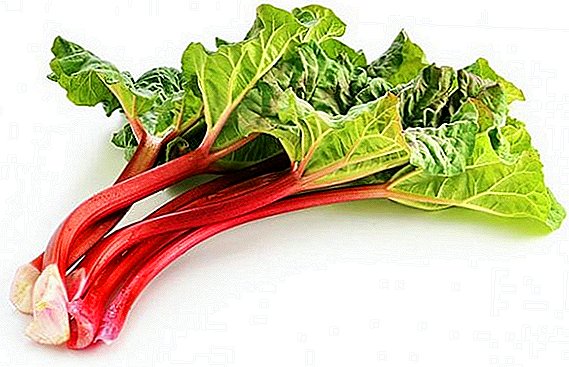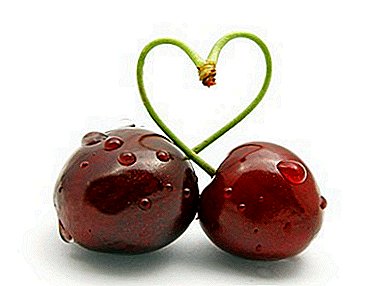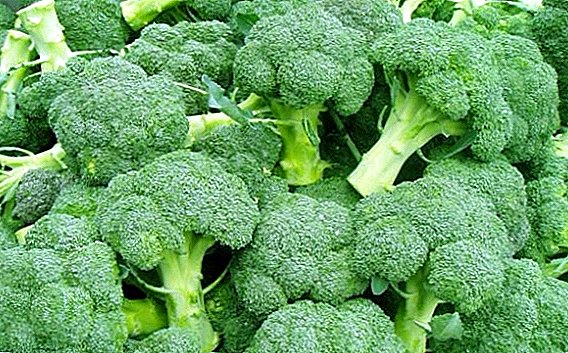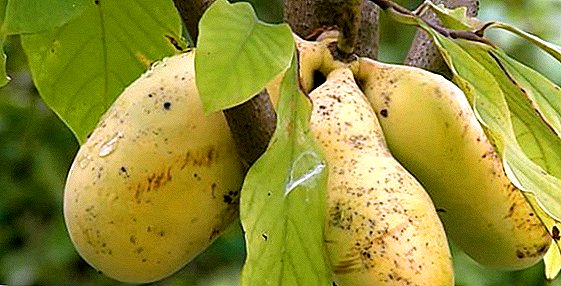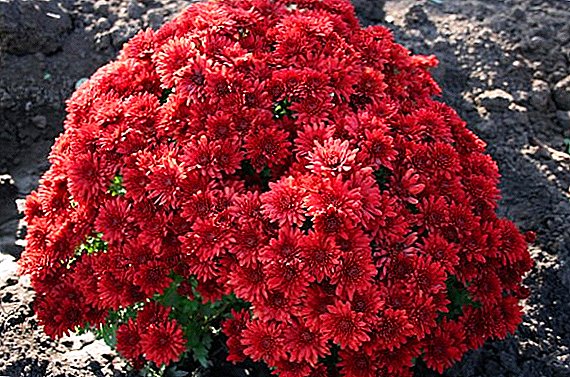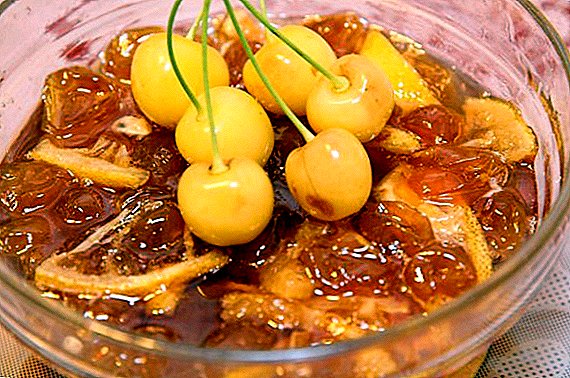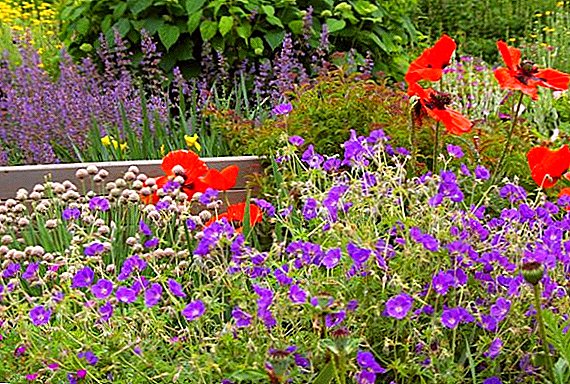 Perennial flowers in the garden have clear advantages compared to annuals: you do not need to plant every year, they have a high decorative effect and, finally, choosing the right plants, you can achieve not only the perfect color spectrum, but also constant flowering in your garden from early spring to late fall.
Perennial flowers in the garden have clear advantages compared to annuals: you do not need to plant every year, they have a high decorative effect and, finally, choosing the right plants, you can achieve not only the perfect color spectrum, but also constant flowering in your garden from early spring to late fall.
In drawing up the flower composition, in addition to the timing of flowering, you must also take into account the size of the plants, the structure and color of their inflorescences.
Did you know? Perennial garden flowers are distinguished by their height - short (up to 50 cm), medium tall (50 - 80 cm) and tall (from 80 cm and up); by type of root - tuberous, rhizomatous, bulbous, bulbotuber.
Perennials blooming in spring
Spring flowers in the country belong to low-growing ornamental plants, bloom in small flowers (more often they have pastel colors). The timing and duration of flowering is highly dependent on weather conditions (early or late spring, warm or cold weather).
Adonis
 Adonis (lat. Adonis) - has about 45 species of annual and perennial plants. Actively used in the park and garden art from the XVII century. It blooms in the second half of spring. Stems are simple or branched. Inflorescence is a simple basket. The flowers are bright yellow (there are red) with glossy petals, single (up to 8 outer tepals).
Adonis (lat. Adonis) - has about 45 species of annual and perennial plants. Actively used in the park and garden art from the XVII century. It blooms in the second half of spring. Stems are simple or branched. Inflorescence is a simple basket. The flowers are bright yellow (there are red) with glossy petals, single (up to 8 outer tepals).
Winter-hardy plant, grows well in open, lighted places (slight shading is allowed). The preferred soil is light, moist, with organic matter and lime. Adonis does not like transplants (if necessary, transplant with a lump of earth).
In the culture most often adonis perennials:
- adonis fluffy (A. Villosa) - blooms in May, has pubescent stems, reaches a height of 30 cm;
- Spring adonis (A. Vernalis) or Adonis - blooms in late April - early May, the only medicinal species of adonis (often used as a component of cardiac drugs);
- Adonis Amur (A. Amurensis) - characterized by early flowering, bare stems, leaves with long petioles. Japanese breeders created several hybrids (hinomoto - orange shades, benten - white petals, ramoza - brown with red, etc.).
Important! Adonis is listed in the Red Book and protected by law. Adonis roots are poisonous (should be considered when self-using in treatment). Toxicity protects the plant from pests.
Hyacinth
Oriental Hyacinth (Hyacinthus orientalis) has served as the basis for more than 400 decorative varieties of Hacinth.
Hyacinths are bulbous, after flowering the green stem dries out. Flowers on a thin peduncle collected in the form of a brush. They are simple, terry and many-flowered.
Hyacinths prefer lighted, even (with a slight slope), protected from the wind areas, with light fertile soils. The groundwater level is at least 50 cm. Although hyacinths in the open ground are practically not prone to pests and diseases, care should be constant (loosen the soil 2-3 times, 3 times before blooming, during budding and upon completion of flowering - to fertilize periodically watered).  Simple hyacinths vary in color and are divided into 6 groups:
Simple hyacinths vary in color and are divided into 6 groups:
- whites ("Argentina", "Carnegie", "L'inosans", etc.);
- pink ("Pink Pearl", "Fondant", "Anna Marie", etc.);
- red ("Generale Pelissie", "La Victoire", etc.);
- blue (Miozotis, Maria, King Oz Blues, etc.);
- lilac / purple ("Amethyst", "Bismarck", "Lord Balfour");
- yellow / orange ("Yellow Hummer", "Orange Bowen").
Did you know? For more than 16 years, the selection of the only black hyacinth - Midnight Mystique - lasted. For the first time a new variety was introduced in 2005 by Thompson Morgan.
Among the terry hyacinths, the most famous are Prince Arthur, Madame Sophie, Groevostrust, Edison, San Flower, and others; from many-flowered - "Pink Pink Festival", "White White Festival", "Blue Blue Festival").
Crocus
Crocuses (Crocus) - undersized perennials, flowering in spring and autumn (varieties of crocus saffron and beautiful crocus), tuber-bulbous plants (about 80 species), with basal leaves. Spring crocus (C. vernus) - one of the progenitors of cultivated varieties. Since the end of the 19th century, more than 50 decorative varieties have been bred. These plants are good honey plants. Bloom in March and April. Crocus is known to humanity for thousands of years, because it is from it that the most expensive seasoning is obtained - saffron.  Crocuses love a lot of sun, light fertile soil. The plant is not afraid of the wind. The most decorative looks in groups of several tens to hundreds of flowers.
Crocuses love a lot of sun, light fertile soil. The plant is not afraid of the wind. The most decorative looks in groups of several tens to hundreds of flowers.
Important! Until the crocus leaves completely wither, they cannot be cut (or mown), because they are the roots that accumulate nutrients for the next season.Among the most popular varieties are lilac-white Vanguard, purple Purpureus grandiflorus, soft lilac Ruby Gaint, yellow Queen of Blues, white Jeanne d'Arc, etc.
Narcissus
Narcissus (Narcissus) - from the Greek "narka" - "intoxicating smell." Bulbous plant of the Amaryllis family, which includes more than 40 species, hundreds of varieties and hybrids.
All daffodils have straight pedicels without leaves, large upright (drooping) one- or two-color flowers. Leaves - thin basal. Bloom in March and April. 
Did you know? The first began to cultivate daffodils Persians. In the Persian lyrics, narcissus personified the eyes of the beloved. In ancient Greek mythology there is a myth about the origin of the flower - the young man Narcissus fell in love with his own reflection and died from unrequited love. In the place of his death beautiful flowers of death bloomed. Daffodils in ancient Rome awarded the winners.The classification of daffodils is rather complicated, and they can be:
- tubular - named because of the prvenchik in the form of a tube. Height grows from 15 to 45 cm ("Mount Hood", "King Alfred", "Liliput" and others (colors white, yellow and white, yellow);
- coarse-crowned - the prvenchik has a size of about a third of the length of the petals Height - 60 cm ("Salome", "Carlton", etc. (yellow, two-color with an orange crown and white colors);
- small-crown - a small cup of tea. Height - up to 45 cm. It blooms in May. The coloring is two-tone, the crown is orange ("Barret Browning").
- terry - no tube, the leaves near the flower bed are arranged in several circles ("Acropolis", "Tahiti", "Rip van Winkle", etc.);
- triandrusaceae - the name comes from the Narcissus Triandusa. Inflorescences consist of several wilted flowers. Height - 30 cm ("Liberty Bells", "Ice Wings", "Havera");
-
 cyclameniform - from the narcissus Cyclomenus. Blooms early. The shape of the flower resembles cyclamen. Height - up to 20 cm. The most famous - "Jack Snip", "Beryl", "Dzhetfay", etc.
cyclameniform - from the narcissus Cyclomenus. Blooms early. The shape of the flower resembles cyclamen. Height - up to 20 cm. The most famous - "Jack Snip", "Beryl", "Dzhetfay", etc.
- Zhonklevidnymi - from Narcissus Jonquil. Blossom from April. Have thin leaves, delicate flowers in racemes. Height - 20-30 cm. Famous varieties - "Belle Song", "Baby Moon", etc.
- tacetoid - 4-6 flowers grow on one peduncle. Height - 45 cm. Easily tolerate temperature drops. Known - "Grand Solay d'Or", "Geranium", "Gregford" and others.
- poetic - traditional colors, bloom after all daffodils. Height - 50 cm. Known - "Red Rome", "Aktae", "Sarchedon", etc.
- Split-corded - a hybrid form with a red crown and a three-color coloring. Height - 50 cm ("Pink Vander", "Waldrom", "Cassata", "Orangerie");
- New varieties, first of all, are orchid daffodils - a crown with deep cuts has bent lobes.
Tulip
Tulip (Tulipa) - bulbous herb. The bulb has a flat bottom and a sharp top. On the stem - 12 oval leaves. The height of the stem can reach from 15 to 70 cm. The flower consists of six petals. Pigmentation - monophonic, mixed or two-color.  Tulips are perennial flowers for summer houses that love sunny areas (without drafts), neutral fertile soils and moisture.
Tulips are perennial flowers for summer houses that love sunny areas (without drafts), neutral fertile soils and moisture.
By the time of flowering tulips secrete:
- early flowering (starting to bloom in March) - simple tulips (popular varieties - "Duc van Toll" (red with border), "Candy Prince" (purple) and terry (diameter of terry flowers - from 8 to 10 cm. Popular varieties - Monte Carlo "(yellow)," Abba "(red, blooms for 15 days, the smallest of tulips, reaching a height of only 10 cm);
- Mid-blooming (April-early May) - Triumph bachaloid tulips ("Blenda Flame"; Darwinian hybrids ("Blushing Apeldoorn" orange shades);
- late flowering
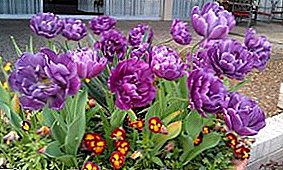 (bloom in early June) - simple tulips of the most diverse colors, peduncle - 75 cm. Red Georgette, a multicolored variety of garnet color, is popular; lilian flowers ("Ballad"); fringed ("Hughes Ten Bosch"); green flowers (because of the greenish color of the petals. Known "China Town" - a white and green bowl with pink tones); parrot (due to greenish spots on bright and variegated petals, in particular, represented by the popular variety "Erikot Perrot" - coral and cream tones); terry tulips (pion-like, monochromatic and two-colored. Known to Blue Diamond - purple).
(bloom in early June) - simple tulips of the most diverse colors, peduncle - 75 cm. Red Georgette, a multicolored variety of garnet color, is popular; lilian flowers ("Ballad"); fringed ("Hughes Ten Bosch"); green flowers (because of the greenish color of the petals. Known "China Town" - a white and green bowl with pink tones); parrot (due to greenish spots on bright and variegated petals, in particular, represented by the popular variety "Erikot Perrot" - coral and cream tones); terry tulips (pion-like, monochromatic and two-colored. Known to Blue Diamond - purple).
Additionally, there are three more classes:
- Kaufman (bloom in March, height up to 32 cm, goblet shape, color monochrome and two-color);
- Foster (has large flowers (18 cm) on short stems, blooming in early April);
- Greig (with patterns of dark red on the leaves).
Important! After the flowering period, when the stems will shrivel and turn yellow to 2/3 of the part, it is advisable to dig out the tulip bulbs. They are dried, treated with fungicide and stored in dry and ventilated rooms at temperatures from +17 to +20 °C. In this case, the flowers will be healthy and strong.
Perennials blooming all summer
Flowering perennials all summer is the largest group of light-loving types of flowers, distinguished by a variety of varieties and duration of flowering.
Pansies
Pansies (50 species) - perennial plants, distinguished by abundant flowering. Height - 15-30 cm, flowers of various colors. The two most famous types of pansies are called "tricolor violet" (Viola tricolor) and "Vitola Vitacle" (Víola wittrokiana), which has larger flowers.  Sunflower loves flower, moist loam. Needs frequent feed (superphosphate). You can extend the flowering time by removing the seed boxes.
Sunflower loves flower, moist loam. Needs frequent feed (superphosphate). You can extend the flowering time by removing the seed boxes.
There are the following varieties:
- small-flowered (3-4 cm) ("Snow Maiden", "Blue Boy", "Little Red Riding Hood");
- large-flowered (up to 6 cm) ("Winter Sun", "Heavenly Queen", "Ice King", "Jupiter");
- giant (7-8 cm), represented by the varieties "Blue", "White", "Golden yellow".
Did you know? In the Middle Ages they believed: in order to achieve love forever, it is enough to lubricate the eyelids of a sleeping person with the juice of this plant and wait for its awakening. In Europe, the beloved gave each other pansies at parting. In England, with the help of this flower, shy youths explained their feelings: they just had to send sweetheart flower with your name.
Astilba
Astilbe (Astilbe) is a perennial herb, among all species (about 30) of which only 10 are cultivated. Flowering begins in June and July. Stems are straight (height is from 8 to 200 cm), leaves are basal green or red-green in color (the outer part of the plant dies off for winter). Blooms with inflorescences-panicles with small flowers (colors - pink, white, red, lilac).  Loves shady places, fertile and loose soil, frequent watering.
Loves shady places, fertile and loose soil, frequent watering.
Popular varieties of astilbe:
- hybrid astilbe "Arends" (A. x arendsii) - blooms from July to August, reaches a height of 60-100 cm, and is characterized by a thin stem with jagged leaves. The coloring of Astilba inflorescences differs depending on the varieties - “Bressingham Beauty” (pink), “Fire” (red), “Germany” (white), “Federsi” (soft pink), etc .;
- David (A. Davadii) - blooms in early July, the flowers are red;
- Thunberg (A. Thunbergii) - blooms in early July, the flowers are pink-red;
- Japanese (A. Japonica) - bloom in May-June, height - 3-40 cm, flowers are white and pink. On its basis, up to a dozen other varieties have been bred (Montgomery, Koblenz, Lara, etc., with flowering in June-July);
- Chinese (A. Chinensis) - bloom in July-August, the flowers are purple, white, pink.
Astrantia is large
Astrantia (Astrāntia), zvezdovka - shrub flowers perennials. The largest popularity in culture has become a large (A. major). It is distinguished by unpretentiousness, it grows on any soils (the better the soil - the more lush the bush). It blooms all summer, while being a good honey plant. Winter-and cold-resistant. Withstands drought. Does not need transplants. Resistant to diseases and pests.  Most popular varieties:
Most popular varieties:
- "Hadspen Blood" (blooms in May - August, height 75-80 cm, loves a light shade);
- "Moulin Rouge" (blooms cherry color from June to August (in the shade the color fades).
Thrift
Armeria (Armeria) - blooms from May to September, the height is from 15 to 60 cm, numerous basal leaves form clumps (pillows), it has a smooth straight stem. Blooms buds of small flowers (red, pink, white and purple). It tolerates drought, while being a cold-resistant plant that does not like too much water.  Popular types:
Popular types:
- Coastal Army (A. Maritima) - height - 20 cm, lilac inflorescences ("Düsseldorf Stolz", "Bladstone", "Rose Compact");
- Alpine Armeria (A. Alpina) - height - 10 cm. It blooms in June ("Alba", "Rosa", "Laushana");
- Pseudo Armeria (Armeria pseudarmeria) - grows with rosettes of leaves, inflorescences are spherical, small white flowers. Famous varieties - "Joystick White", "Bis Ruby").
English roses
English roses - first obtained by crossing old varieties of roses (Damascus, French, Bourbon) with hybrid tea at the end of the twentieth century.  The shape of the flowers - a cup-shaped, strong pink aroma, a variety of shades, and resistance to diseases - were to the taste of gardeners. Flowers English roses in the garden - long-flowering. Flowering begins very early and continues until the frosts themselves. They differ in size (stunted, medium, tall), in the bush (climbing, prostrate), etc. Also, there is a large variety of varieties - white, cream, apricot, copper, red, crimson, yellow, and others. Varieties:
The shape of the flowers - a cup-shaped, strong pink aroma, a variety of shades, and resistance to diseases - were to the taste of gardeners. Flowers English roses in the garden - long-flowering. Flowering begins very early and continues until the frosts themselves. They differ in size (stunted, medium, tall), in the bush (climbing, prostrate), etc. Also, there is a large variety of varieties - white, cream, apricot, copper, red, crimson, yellow, and others. Varieties:
- "Abraham Derby Austin" (apricot rose with 10 cm flower);
- "Suzanne Williams Ellis" (white rose with the smell of rose oil);
- "William Shakespeare" (dense red rose, characterized by long flowering);
- "Charlotte" (flower densely, resembling real gold in color. It has the aroma of tea rose).
knapweed
Cornflowers (Centauréa) - Herbaceous Medium Perennials (emit about 500 species). Among the features of these plants emit upright stems, leaves, arranged in a sequential order, inflorescences - in the form of a basket. Cornflowers love the sun, speaking at the same time frost-resistant plants. Bloom from June to September in pink, blue, white, red and purple flowers. Perennial cornflowers are undemanding, practically do not get sick. Live up to 7-10 years.  The most popular types of cornflowers:
The most popular types of cornflowers:
- meadow (C. Jacea) - blooms from July to frost, flowers - bright purple inflorescences (up to 4 cm in diameter), straight purple shoots, height - 30-80 cm;
- podbelenny (C. Dealbata) - blooms until September, having bright pink flowers, ornamental leaves, stems are straight and branched. Refers to cold-resistant plants. Famous varieties: "John Curtis", "Stembergie";
- mountain (C. Montana) - blooms in July-September with blue-violet flowers, height up to 60 cm ("Alba", "Rose", "Grandiflora").
Gladiolus
 Gladiolus, the sword (from the Latin. Gladius - the sword) is a bulbous perennial plant. Gladioli love fertile soil with good drainage and sufficient sunshine. Height - from 30 cm to 1.5 m. On the stem is located inflorescence of 15-22 flowers. By the time of flowering gladioli are divided into early, medium and late. The most popular varieties of hybrid gladiolus (G. hybridus hort): they are larger, more diverse in color, the number of flowers reaches 32. Flowering - up to 25 days.
Gladiolus, the sword (from the Latin. Gladius - the sword) is a bulbous perennial plant. Gladioli love fertile soil with good drainage and sufficient sunshine. Height - from 30 cm to 1.5 m. On the stem is located inflorescence of 15-22 flowers. By the time of flowering gladioli are divided into early, medium and late. The most popular varieties of hybrid gladiolus (G. hybridus hort): they are larger, more diverse in color, the number of flowers reaches 32. Flowering - up to 25 days.
Important! Gladioli are not recommended to grow in one place for more than two years.
Gypsophila paniculata
Gypsophila (Gypsophila paniculata) - rolling the field or "Loving lime". Shrub plant, blooms paniculate inflorescences of small white / pink flowers. It acquires a spherical shape. It has a high level of cold resistance. The leaves are lanceolate. The height of the stems - up to 120 cm. Presented by the species "Bristol Fairy" (terry inflorescences); "Pink Star"; "Flamingo" and others. 
Mottled Shrub
Potentilla (Dasiphora), Kuril tea, mighty and others (has 500 species). Flowering falls at the end of summer - the beginning of autumn. The bush reaches a height of 50 - 150 cm. It has a high cold resistance.  The most popular varieties of Potentilla:
The most popular varieties of Potentilla:
- Friedrichsen potentilla (D. Friederichsenii) - a hybrid ("blend" of Kuril tea and Daurian sausage);
- "Abotswood" - height 75 cm, white flowers;
- "Catherine Duques" - height 1.5 m, yellow flowers;
- "Tanjerin" - height 60 cm, bronze color of flowers.
Large-flowered flax
Large-flowered flax (Linum grandiflorum) is a grassy, unpretentious plant that is very fond of light. It can be called frost resistant and not demanding in terms of planting and maintenance, as it grows on any soil (but without water stagnation). Lena blooms from June to September, height is 35-60 cm. The plant has thin stems, red or blue flowers with 5 petals (3.5 cm), leaves are narrow. Flowers fade by the end of the day, new ones bloom in the morning. The only negative is the annual plant, although it is sometimes grown as a perennial. 
Bell
Колокольчик (Сampanula) - многолетнее травянистое растение (различают около 300 видов). Соцветия в виде кисть или метелки, форма цветка - колокольчик. Расцветка - фиолетовый, синий, белый, розовый, голубой. Колокольчики любят солнце и не выносят застоя воды. Prefer light soils, loams.  The most popular types of bells:
The most popular types of bells:
- the bell is medium (it blooms in white, blue, pink and blue flowers, winter-hardy variety);
- Bell Portenshlag (flowers of purple hue, on the shoot - up to 5 flowers, frost-resistant variety);
- Bell Pozharsky (small flowers of lilac, blue, pink flowers, cold-resistant variety).
Clematis
Clematis (Clematis) - shrubs, dwarf shrubs, lianas (more than 300 species). They prefer the sun, do not like shadow and half-shade, drafts, and wet lowlands. They are divided into groups based on the formation of flowers:
- on last year's shoots (flowering occurs at the end of May - beginning of June). Popular varieties "Alpina" and "Macropetala";
- on the current and last year's shoots. The first wave of flowering in early summer, the second (main) - in the middle of summer. The most famous varieties "Lanuginosa" (flowers of white and blue), "Patents", etc.
- on the current shoots. It blooms from July to the frosts themselves (varieties "Zhakmana", "Vititsella", "Integrifolia", etc.).

Salvia oakwood
Salvia nemorosa, Salvia sylvestris is a herbaceous perennial plant. The stem has lanceolate wrinkled leaves, blooms in the end of June with spike-like inflorescences, has a strong aroma.
Loves sunshine, light fertile soil. Does not like a lot of moisture. It has a high frost and drought tolerance. 
Important! Sage forest can be made to bloom all summer and even in September, if you cut off all the young shoots after the first wave of flowering.The varieties of sage forest vary in size:
- undersized and medium-grown varieties ("Markus" - height 25 cm with blue flowers; "Plumos" - up to 40 cm, lavender; "Pink Queen" - up to 60 cm, with pink flowers, etc.);
- tall - up to 80 cm ("Amethyst" - pink-purple flowers; "Adrian" - white flowers; "Caradonna" - black stem with dark purple flowers).
Perennials blooming in the fall
At the end of summer - the beginning of autumn, they begin their flowering, which continues until the first frost, beautiful late perennials for dacha - aconite, anemone, chrysanthemum, etc.
Aconite rent
 Aconite Arendsa (Aconiteum arendsii) - perennial plants, the result of interspecific crossing. Begin to bloom in mid-summer white, blue and two-tone flowers.
Aconite Arendsa (Aconiteum arendsii) - perennial plants, the result of interspecific crossing. Begin to bloom in mid-summer white, blue and two-tone flowers.
Height reaches 100 cm. Possess high frost resistance.
Did you know? The poisonous properties of aconite are known since ancient times - poison was made of a plant from a plant, and also poisoned to enemies water to drink. According to the legends, the conqueror Timur died of aconite poisoning (his skullcap was soaked with poison).
Japanese autumn anemone
Anemone (Anemone) autumn - a plant whose birthplace is Japan and China. The height reaches 1.5 m, the leaves are large, dark green. Flowering begins in September - blooms with double or simple flowers (6 cm in diameter) in white, pink, cream and red shades.  Japanese anemones like bright light, light and fertile soil, good watering.
Japanese anemones like bright light, light and fertile soil, good watering.
Important! Anemone juice is bitter in taste and irritates the skin and mucous membranes.The most famous species and hybrid varieties:
- Hubei anemone (with light pink flowers);
- hybrid anemone ("Honorin Zhobert", "Profuson", "Queen Charlotte").
Autumn crocus (wintery)
Colchicum (Colchicum autumnale) is a herbaceous perennial (has 65 species) that looks like a crocus. Flowering - September-October (up to three weeks). The flowers have the shape of a glass (in diameter - up to 7 cm), a pleasant aroma. Depending on the variety can be simple or double. The colors are white, pink, purple and maybe with different shades. The leaves during the flowering period are absent (their height is 30-40 cm), the stem of the flower is 8-20 cm. It loves sandy soils and grows equally well in the shade and in the sun. Watering is not required.  Especially popular variety "Roseum Plenum" with delicate pink flowers.
Especially popular variety "Roseum Plenum" with delicate pink flowers.
Vernonia
Vernonia (Vernonia) is a perennial of the Astrov family (1000 species). Garden culture - vernonia shaggy (Vernonia crinita). The stems of this plant are erect with large oval leaves. Blossoming falls on August - September, and inflorescences are represented by panicles of purple flowers. Loves the sun, moist fertile soil. 
Sedum
Sedum, Sedum (Sedum) is a perennial plant of the Tolstyankov family (there are about 600 species in total). Blooms in small flowers in fluffy inflorescences. Color - pink, yellow, red, blue, etc.
Sedum like large sunny areas, light penumbra. It is unpretentious to soils and grows well both on stony and sandy soils, and on more fertile ones. They belong to drought-resistant species.  There are three groups of stonecrop - short, medium tall (bloom at the end of summer) and tall - bloom in the fall (stonecrop tenacious, stonecrop visible and stonecrop telephium or "hare cabbage").
There are three groups of stonecrop - short, medium tall (bloom at the end of summer) and tall - bloom in the fall (stonecrop tenacious, stonecrop visible and stonecrop telephium or "hare cabbage").
Nerina
Nerine (Nerine) is a bulbous perennial plant (30 species) of the Amaryl family. It blooms in early or mid autumn. The height of the stems reaches 50 cm, and the plant itself blooms with red, white, pink or orange flowers in umbellate inflorescences (often called spider lily).
Popular varieties:
- Nerine "Bowden" - the most cold-resistant form. It blooms in the middle of autumn with umbrella inflorescences (12 flowers each);
- Nera sinuous - has beautiful white and pink flowers, collected in inflorescences and presented in the form of bells.

Tricyrtis
Tricyrtis (Tricyrtis), garden orchid - a perennial plant of the family Lily. It blooms from late summer and may continue to bloom until frost. Flowers - pink with crimson spots, collected in bunches.  The plant loves forest soils, with a fairly large amount of humus and peat.
The plant loves forest soils, with a fairly large amount of humus and peat.
Did you know? One of the names of tricyrtis - "toad lily", is given due to the use of plant sap to bait edible toads in the Philippines.Most popular varieties:
- tricyrtis short-haired (80 cm tall, with white flowers and crimson spots on them, the most cold-resistant variety);
- broadleaf tricyrtis (60 cm tall, green and white flowers).
Chrysanthemum
Garden chrysanthemum (Chrysanthemum) has more than 650 varieties. Autumn chrysanthemums are very different from each other: the inflorescences can be simple, semi-double, terry, painted in different shades of red, pink, yellow, white. Autumn varieties can tolerate even the first frost. Depending on the timing of flowering, you can select such plants in this group:
- early flowering - starting to bloom in early August (varieties Goldmaryan (yellow terry inflorescences), Kleiner Bernstein (yellow-brown flowers), Mei-Kio (pink flowers);
- mid-flowering - flowering begins from mid-September (varieties "Felbacher Vine" (red flowers), "Isabelrosa" (yellow-pink flowers);
- late-flowering perennial flowers for flower beds - gardeners begin to delight with their beauty from November (varieties Vreneli (red flowers), Ordenstern (bronze flowers).



 cyclameniform - from the narcissus Cyclomenus. Blooms early. The shape of the flower resembles cyclamen. Height - up to 20 cm. The most famous - "Jack Snip", "Beryl", "Dzhetfay", etc.
cyclameniform - from the narcissus Cyclomenus. Blooms early. The shape of the flower resembles cyclamen. Height - up to 20 cm. The most famous - "Jack Snip", "Beryl", "Dzhetfay", etc. (bloom in early June) - simple tulips of the most diverse colors, peduncle - 75 cm. Red Georgette, a multicolored variety of garnet color, is popular; lilian flowers ("Ballad"); fringed ("Hughes Ten Bosch"); green flowers (because of the greenish color of the petals. Known "China Town" - a white and green bowl with pink tones); parrot (due to greenish spots on bright and variegated petals, in particular, represented by the popular variety "Erikot Perrot" - coral and cream tones); terry tulips (pion-like, monochromatic and two-colored. Known to Blue Diamond - purple).
(bloom in early June) - simple tulips of the most diverse colors, peduncle - 75 cm. Red Georgette, a multicolored variety of garnet color, is popular; lilian flowers ("Ballad"); fringed ("Hughes Ten Bosch"); green flowers (because of the greenish color of the petals. Known "China Town" - a white and green bowl with pink tones); parrot (due to greenish spots on bright and variegated petals, in particular, represented by the popular variety "Erikot Perrot" - coral and cream tones); terry tulips (pion-like, monochromatic and two-colored. Known to Blue Diamond - purple).
